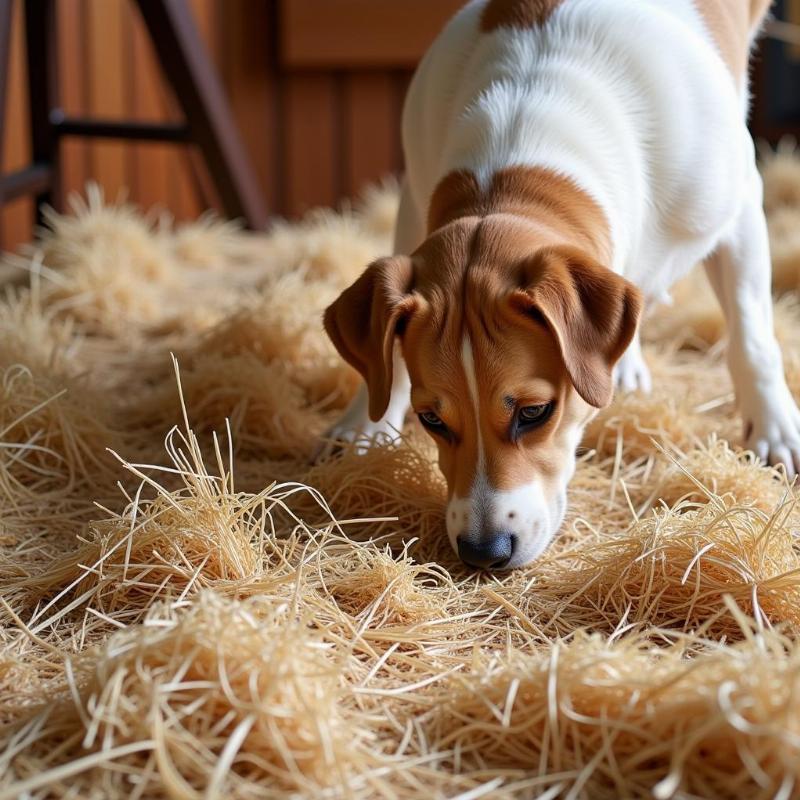Pine straw is a common and readily available material, especially in the southern United States. Many homeowners use it for landscaping, and it’s often touted as a natural and affordable option for various purposes. But is pine straw good for dog bedding? The short answer is: it’s complicated. While pine straw offers some potential benefits, there are important considerations and risks to be aware of before using it for your canine companion. Let’s delve into the pros and cons to help you make an informed decision.
Exploring the Pros and Cons of Pine Straw Bedding for Dogs
Pine straw can be appealing as a dog bedding material due to its natural aroma, seemingly soft texture, and cost-effectiveness. It’s readily available and biodegradable, which can be attractive to environmentally conscious pet owners. However, it’s crucial to weigh these advantages against potential drawbacks to ensure your dog’s safety and comfort.
Potential Benefits of Pine Straw
- Cost-Effective: Pine straw is generally less expensive than other bedding options like cedar chips or commercial dog beds.
- Natural and Biodegradable: Its natural origin and biodegradability make it an eco-friendly alternative to synthetic materials.
- Insulating Properties: Pine straw can provide insulation, potentially keeping dogs warm in colder weather.
- Pleasant Aroma: Many people enjoy the natural pine scent.
Risks and Concerns of Pine Straw Bedding
- Sharp Needles: Pine needles can be sharp and potentially poke or irritate a dog’s skin, especially for sensitive breeds. They can also become embedded in paws or other areas.
- Potential Allergens: Some dogs are allergic to pine or other conifer trees, which can lead to skin irritation, respiratory issues, or other allergic reactions.
- Pesticide Residue: If the pine straw has been treated with pesticides, these chemicals can be harmful to dogs if ingested or absorbed through the skin.
- Mold and Mildew: Pine straw can retain moisture, creating a breeding ground for mold and mildew, which can cause respiratory problems and other health issues for dogs.
- Ingestion Hazard: Dogs, especially puppies, may ingest pine needles, which can cause gastrointestinal upset or blockages.
- Cleaning Challenges: Pine straw can be messy and difficult to clean, as needles can easily scatter and become embedded in fabrics.
 Pine straw as dog bedding – pros and cons
Pine straw as dog bedding – pros and cons
Is Pine Straw Safe for Puppies?
Puppies are particularly vulnerable to the potential hazards of pine straw. Their smaller size and tendency to chew and explore make them more likely to ingest pine needles, leading to choking hazards or digestive issues. Their developing immune systems also make them more susceptible to allergens and toxins. Therefore, pine straw is generally not recommended as bedding for puppies.
Alternatives to Pine Straw Bedding
Several safer and more comfortable bedding options exist for dogs, including:
- Dog Beds: Commercial dog beds come in various sizes, shapes, and materials, offering support and comfort.
- Blankets: Soft, washable blankets provide warmth and comfort.
- Cedar Chips: Cedar chips offer a natural, insect-repelling option, but ensure they’re kiln-dried and untreated.
- Veterinary-Approved Bedding: Consult with your veterinarian for recommendations on specialized bedding for specific needs, such as orthopedic conditions or allergies.
What if My Dog Already Sleeps on Pine Straw?
If your dog currently sleeps on pine straw without any apparent issues, carefully monitor them for any signs of discomfort, skin irritation, or respiratory problems. Consider transitioning to a safer bedding alternative and consult your veterinarian if you have any concerns.
Creating a Safe and Comfortable Sleeping Environment for Your Dog
Providing a safe and comfortable sleeping space is essential for your dog’s well-being. Choose bedding that is soft, clean, and free of potential hazards. Regularly wash or replace bedding to maintain hygiene and prevent the growth of bacteria, mold, and mildew.
Frequently Asked Questions (FAQ)
- Is pine straw toxic to dogs? While not inherently toxic, the sharp needles and potential for pesticide residue pose risks.
- Can pine straw cause allergies in dogs? Yes, some dogs are allergic to pine and can experience skin or respiratory reactions.
- What’s the best bedding for dogs with allergies? Hypoallergenic dog beds made from materials like microfiber or cotton are good options.
- How often should I change my dog’s bedding? Ideally, wash or replace bedding weekly, or more frequently if soiled.
- Can I use hay as dog bedding? Hay is not recommended as it can harbor mold and dust mites.
Conclusion
While pine straw might seem like a readily available and affordable bedding option, the potential risks outweigh the benefits, particularly for puppies. Prioritize your dog’s safety and comfort by choosing a safer and more suitable bedding material, ensuring a healthy and restful sleep. If you have questions about your dog’s bedding or any other health concerns, consult your veterinarian. They can provide personalized advice based on your dog’s breed, age, and individual needs.
Beautdogs.us is your trusted source for comprehensive and engaging information on dog care, breeds, and products. We’re dedicated to helping dog owners in the US provide the best possible care for their canine companions. Whether you’re a new dog owner or a seasoned pro, Beautdogs.us offers expert advice and resources to support you every step of the way. Contact us today for personalized assistance! Email: [email protected], Phone: +1 501-555-7529. Visit us online at Beautdogs.us for more helpful tips and information.